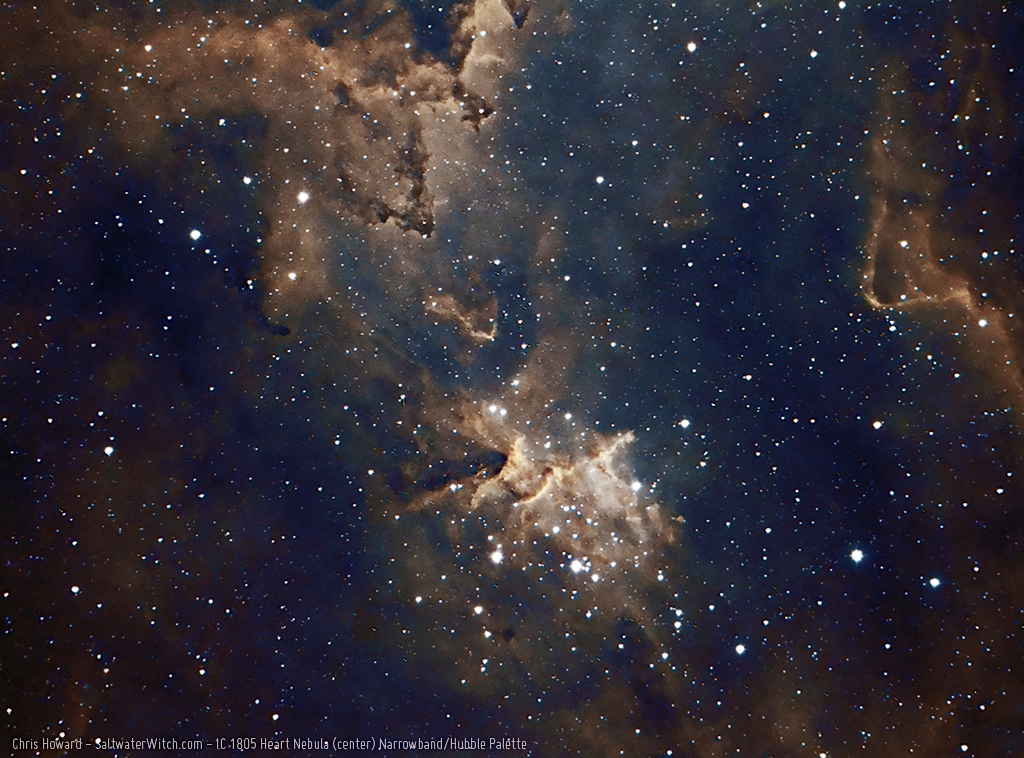Astro Session - January 10, 2018
The temps are nice--downright warm compared to what we've been hit with over the last couple weeks. The clouds are the problem. They gave me two hours of clear skies, and I spent them taking a batch of five minute exposures of M42, the Orion Nebula. (Atik414Ex mono CCD, William Optics GT-81 + 0.8x Field Flattener/Reducer f/4.7, iOptron CEM25P EQ mount, Astronomik 12nm Ha filter, WO 50mm guidescope with ZWO ASI120S-MM guide cam, INDI/KStars/Ekos observatory control).

Posted January 10, 2018
Astro Session - December 26, 2017
I took several hours of hydrogen-alpha, oxygen 3, sulfur 2, and RGB images last night. Here's the color version of the Rosette Nebula (nebular region) with OIII and SII frames added to a bunch of Ha frames I shot at the beginning of the month.
Okay, this new astro setup worked well (see yesterday's post). I just bolted on the mount, did a quick polar alignment, and I was taking beautiful twenty-minute exposures of NGC 1499 (California Nebula). I shot some hydrogen-alpha of the California while waiting for the Rosette Nebular region to come into view.
I have been on this automated portable astrophotography path for a while; it's been a slow but continuous process of remote controlling my entire astro imaging rig from anywhere. I set it up, and as long as there's power and wifi, I'm good to go. This latest iteration, making the whole rig portable, is going to make things easier on those nights when I know I'll only have two hours of clear skies. Before now I wouldn't even think about setting up because that could eat up an hour alone. (Atik414Ex mono CCD, William Optics GT-81, CEM25P EQ mount, WO 50mm guidescope with ZWO ASI120S-MM guide cam, INDI/KStars/Ekos observatory control)

Four stacked 1200-second frames of NGC 1499 with the 12nm Astronomik Ha filter:

Posted December 26, 2017
Astro Session - December 26, 2017
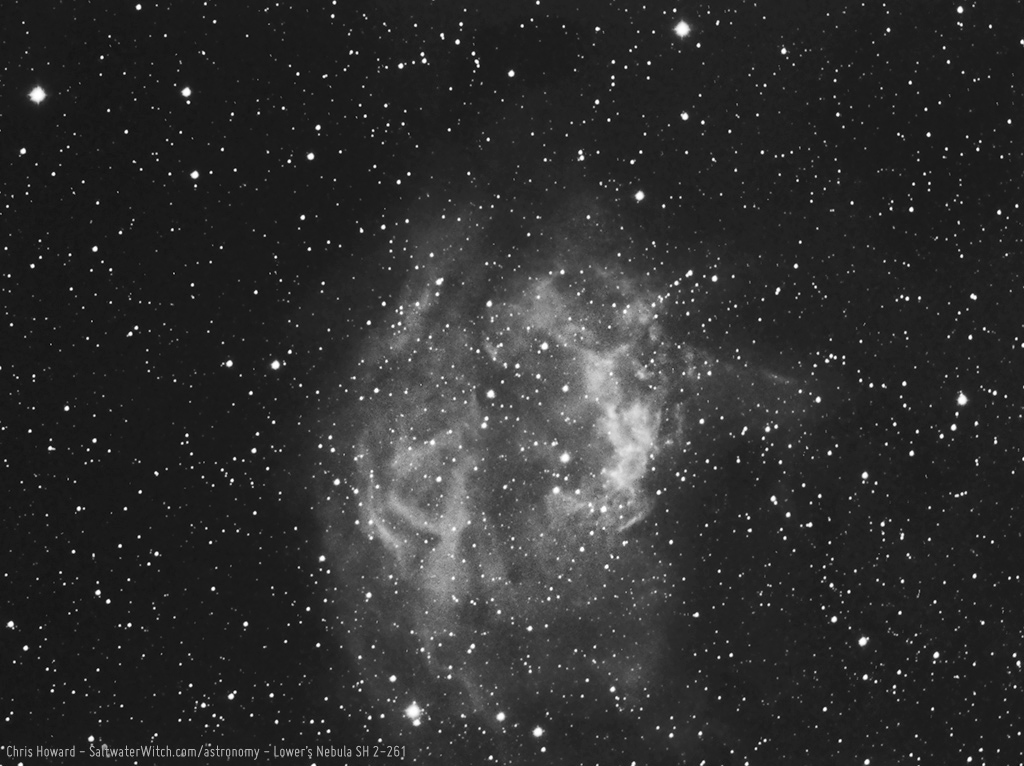 A couple test Ha frames of Lower's Nebula (SH 2-261) in the constellation Orion. I only took two exposures of Lower's Nebula while waiting for the Rosette Nebula to rise, and it reminded me of a scene in the movie Roxanne with Steve Martin (CD Bales) and Daryl Hannah (Roxanne):
A couple test Ha frames of Lower's Nebula (SH 2-261) in the constellation Orion. I only took two exposures of Lower's Nebula while waiting for the Rosette Nebula to rise, and it reminded me of a scene in the movie Roxanne with Steve Martin (CD Bales) and Daryl Hannah (Roxanne):
C.D. Bales: You must know about M31.
Roxanne: Yeah.
C.D. Bales: Now, see, I like it when they give astronomical objects names, you know, like "Andromeda" and "Saturn" and "Sea of Tranquility." This whole numbering thing is just too boring for us civilians.
Roxanne: Do you know how many objects are up there?
C.D. Bales: Well, I know it's over fifty.
That's the problem when you're a constellation like Orion, with a nebula so massive and bright you can see it clearly without a telescope (M42), or you possess dark nebular structures famously shaped like animals (Horsehead nebula, Barnard 33). You get overlooked if you're not a superstar or supernova remnant or "The Great" Orion Nebula. Yeah, that's Lower's Nebula (SH 2-261), which I'm sorry to say, I had never heard of before last night. Unfortunately that's probably because Lower's Nebula isn't the buckle on Orion's Belt. It isn't even hanging off of Orion's famous belt. It is literally out on a distant arm of the constellation--yes, Orion has one arm raised, far away from the Belt, and the famous stars like Betelgeuse, Bellatrix, and Rigel, and that's where you'll find this obscure cloud of hydrogen that doesn't even have a wikipedia page (In English. I found an Italian page for SH2-261. Nicely done, Italy.)
(Subframe info: one 600-second exposure and one 1200-second exposure stacked in DSS, no calibration frames, Atik414Ex mono CCD running at -10C, Astronomik 12nm Ha filter, William Optics GT-81, CEM25P EQ mount, WO 50mm guidescope with ZWO ASI120S-MM guide cam, INDI/KStars/Ekos observatory control)
Posted December 26, 2017
Astro Session - December 1, 2017
We were very close to a full moon last night, so my astro imaging options were limited to narrowband. I spent most of the night with Hydrogen-alpha, an inexpensive 12nm Astronomik filter, but as you can see, able to bring out some fantastic contrast, depth, and details throughout this region of interstellar ionized hydrogen. (This is the filter I currently have in the 1.25" wheel. My Baader 6nm Ha is in the 2" filter wheel)
The "Rosette Nebula" is a cluster of nebulosity that includes NGC 2237, NGC 2238, NGC 2244, NGC 2239, NGC 2246 and more. The Rosette is a bright mag 9 area of the sky about 1.3° across in the constellation Monoceros. (subframe info: 28 600 second exposures in hydrogen-alpha, no calibration frames, Atik414Ex mono CCD running at -10C, Astronomik 12nm Ha filter, William Optics GT-81, CEM25P EQ mount, WO 50mm guidescope with ZWO ASI120S-MM guide cam, INDI/KStars/Ekos observatory control). https://www.astrobin.com/324406/
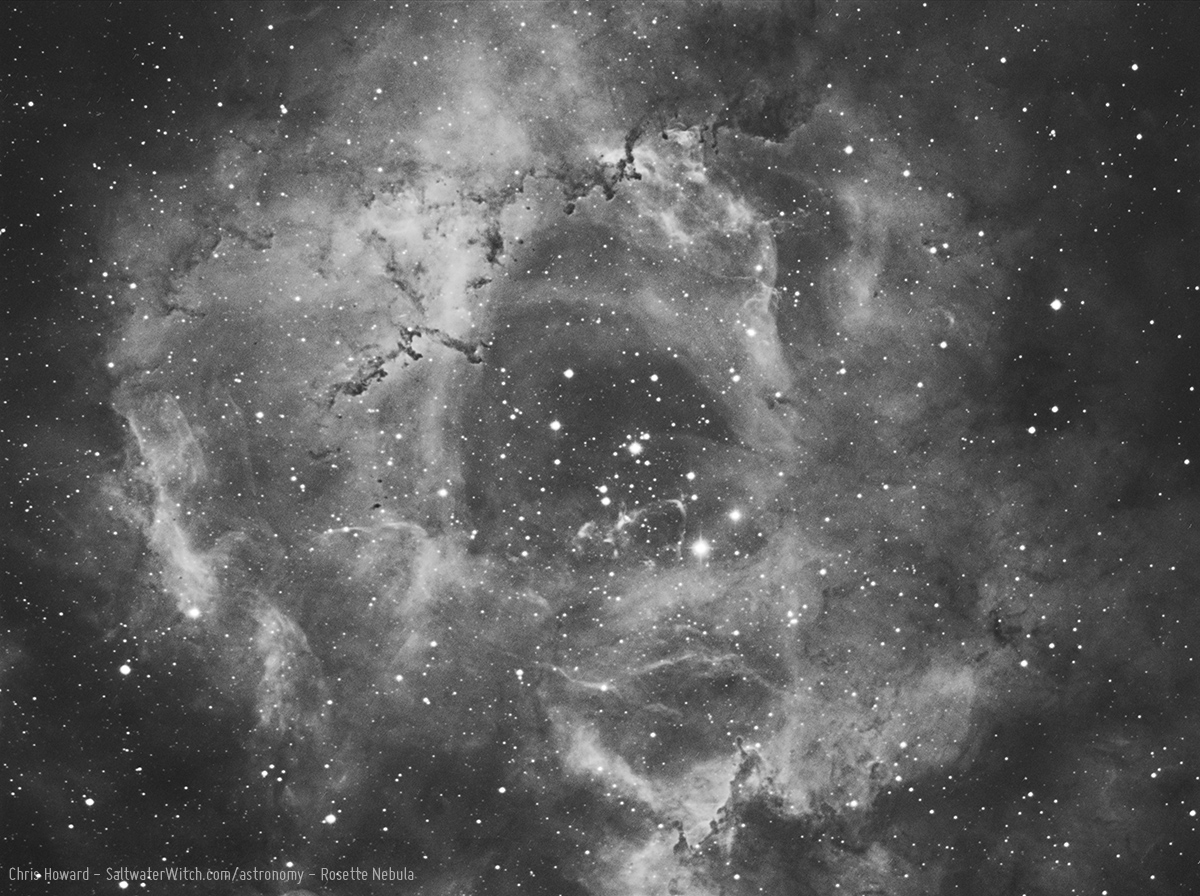
One of many reasons I love the Atik 414EX is how clean (free of noise) the light frames are when you cool the sensor down to -10C or below. I didn't shoot dark frames, or any other calibration frames last night, and didn't use any from my library when stacking.
My last target of the night: center portion of IC 2177, the "Seagull Nebula" in the constellation Monoceros. There's noise that showed up during stretching, but this one of IC 2177 is just 4 stacked Ha frames, each 600 seconds.
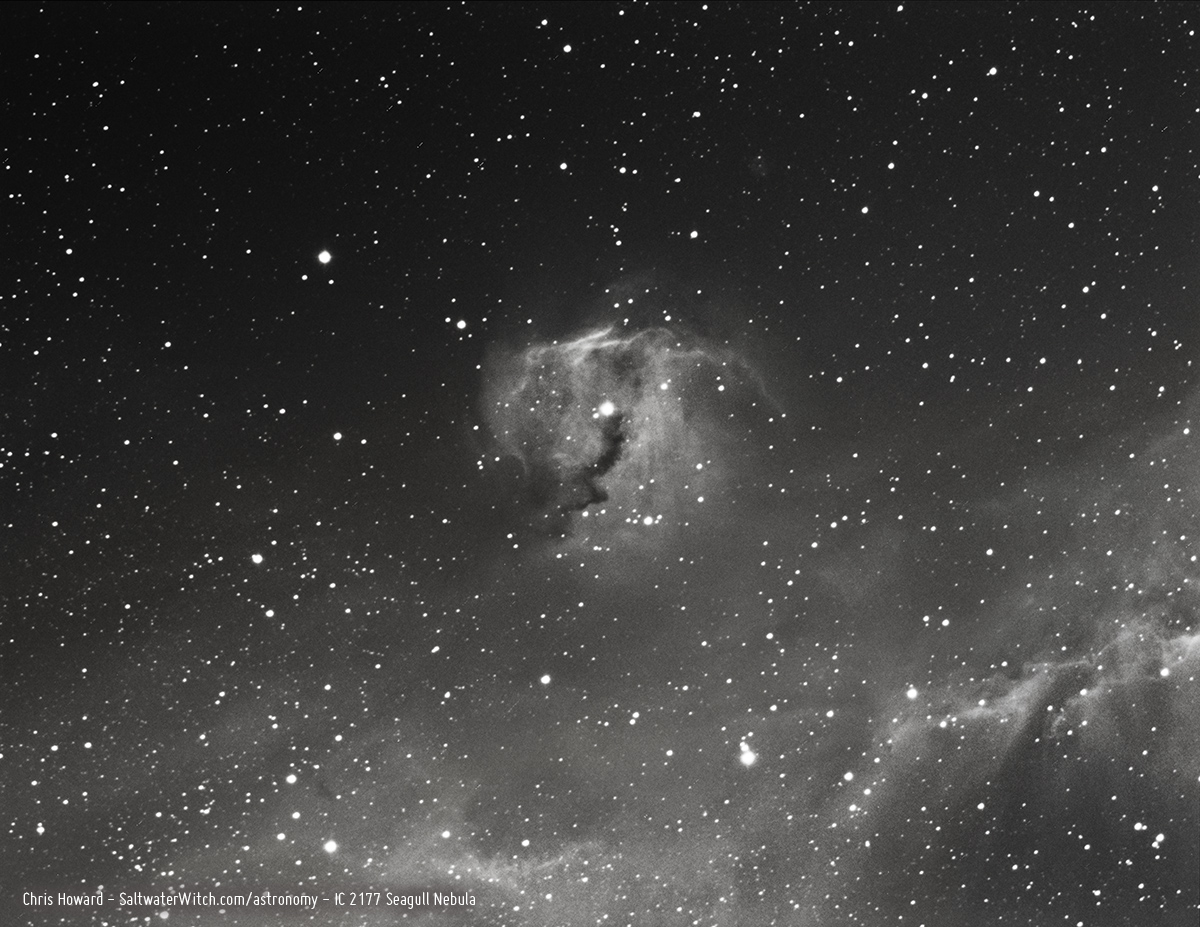
Here's a screenshot of Ekos and KStars, in the process of capturing 600 seconds of photons landing in my backyard from the Rosette Nebula. This is pretty much what I see--the tools I work with--when remotely controlling the mount, telescope, cameras, targeting, focusing, plate solving, and more. And that's what a single 600-second frame looks like. With stacking I'm obviously getting a lot more signal to noise.
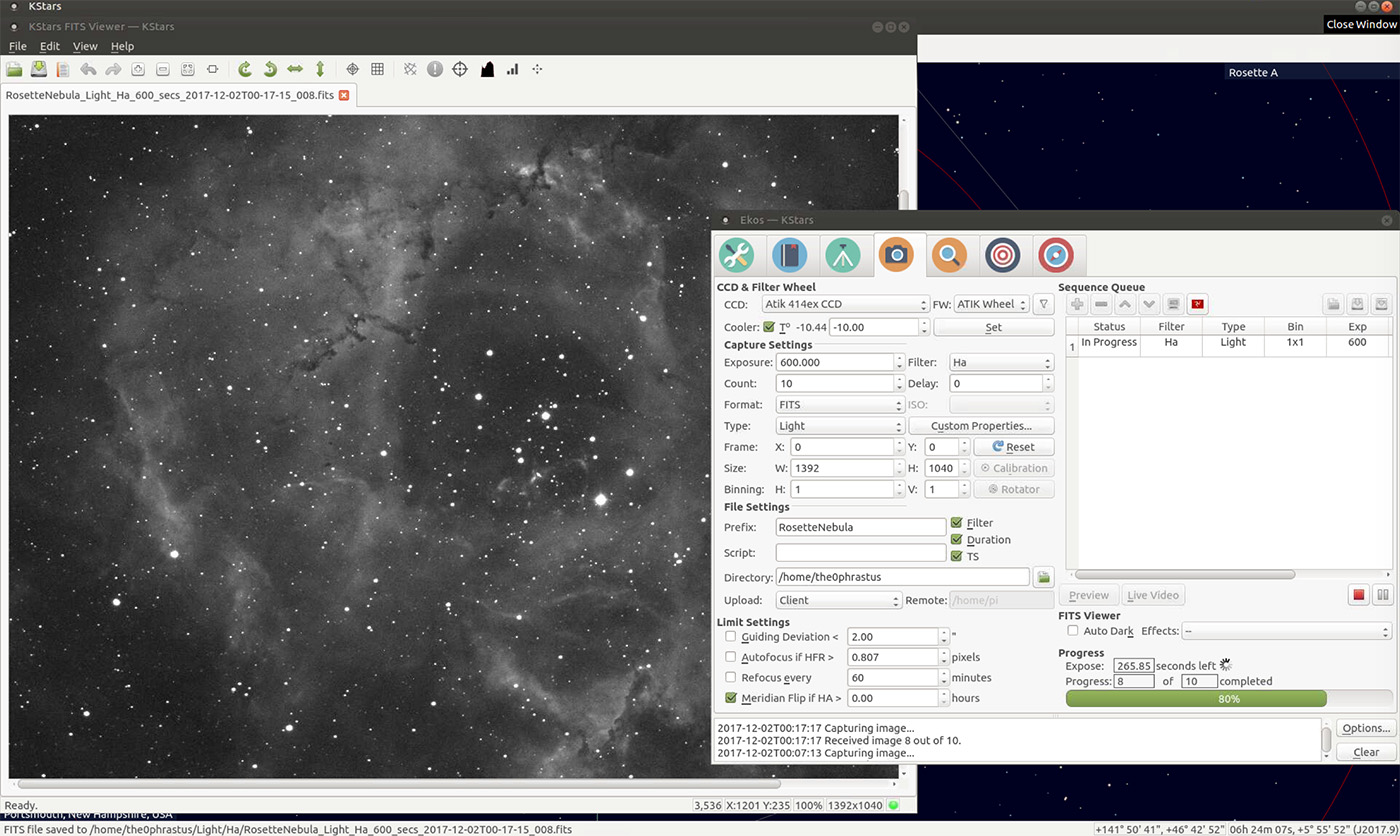
Posted December 1, 2017
Astro Session - October 13, 2017
IC 405--"Flaming Star Nebula" in the constellation Auriga, centered on the mag. +6 star AE Aurigae. It's relatively close to us, at about 1,500 light-years. This set of subframes covers the center of the fairly large nebula, which measures 37 x 19 arcminutes. (6 x 1200 second subs in Ha, O3, S2, taken with my current main setup: Atik414Ex mono CCD, William Optics GT-81, CEM25P EQ mount, WO 50mm guidescope with ZWO ASI120S-MM guide cam, INDI/KStars/Ekos observatory control).

Posted October 13, 2017
Astro Session - October 12, 2017
NGC 281 (IC 11, Sh2-184) "Pacman Nebula" in the constellation Cassiopeia. More narrowband imaging, although the moon is waning, and didn't even make into the sky until the early morning hours. I completed the subs for NGC 281 by 1am, and scheduled some narrowband exposures of IC 405, Flaming Star Nebula. (subframe info: 6 x 1200 second exposures in Ha, 5 x 1200 sec OIII & SII with 16 dark frames, Atik414Ex mono CCD, Astronomik 6nm Ha, OIII, SII, William Optics GT-81, CEM25P EQ mount, WO 50mm guidescope with ZWO ASI120S-MM guide cam, INDI/KStars/Ekos observatory control).
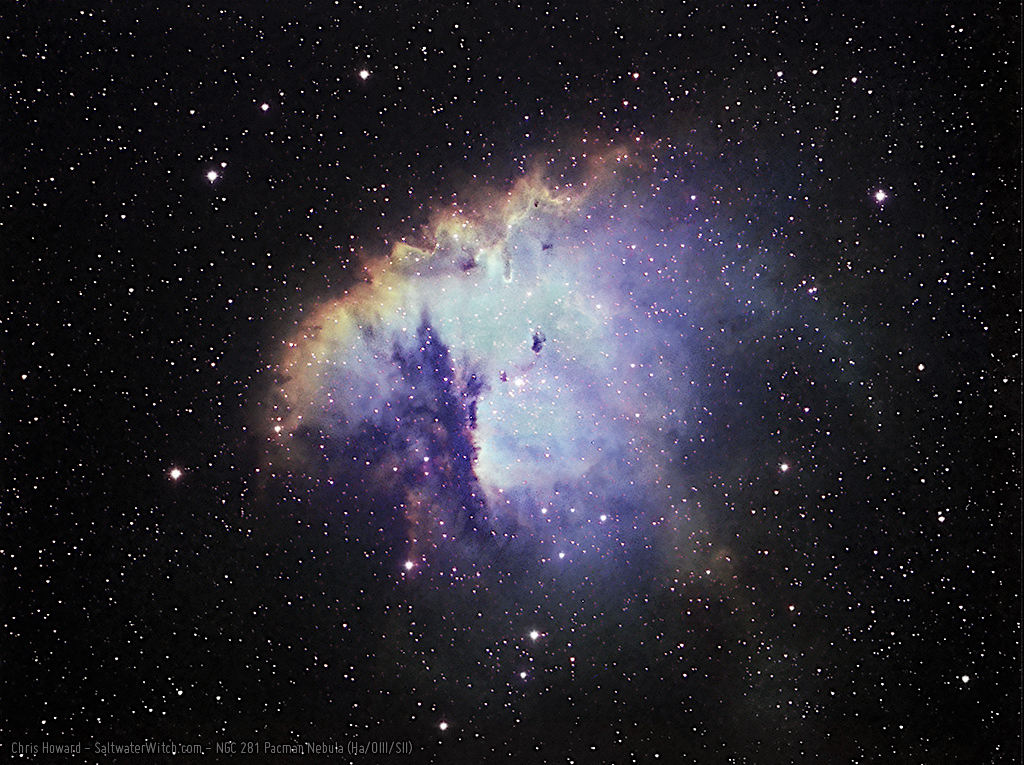
Posted October 12, 2017
Astro Session - October 5, 2017
NGC 6888 - Crescent Nebula in Ha (4 x 1200 second subs + 15 dark frames stacked in DSS). I continued my hydrogen alpha campaign tonight, with a couple more targets, including the Crescent. My goal over the next month or two is to continue capturing these nebulae in O3 and S2, and use those results with these Ha shots to produce color images. I may also test out some Ha+RGB image processing on a couple of the brighter ones like IC 1369a, the Elephant Trunk Nebula.
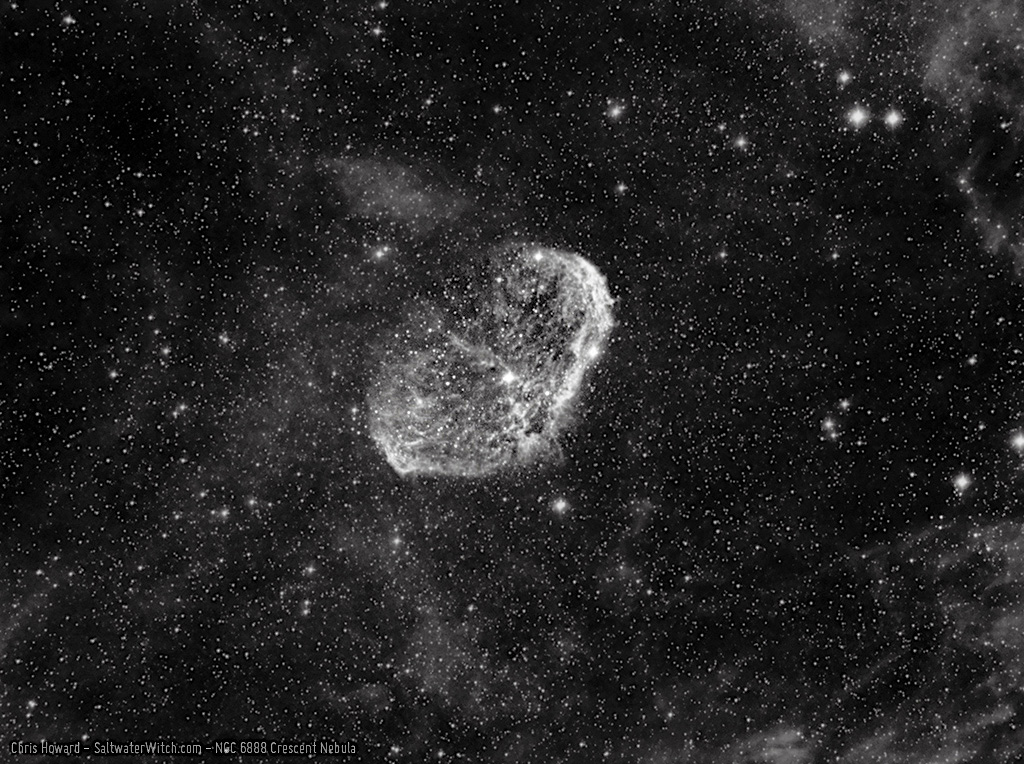
Posted October 5, 2017
Astro Session - October 5, 2017
I finally made some time to process one of the image sets I shot on October 2, and here's one result: narrowband of the central region of the emission nebula IC 1805, the Heart Nebula, which is only 7500 lightyears away in the constellation Cassiopeia. (It's almost in our backyard!) I used the "Hubble Palette", mapping the separate hydrogen alpha, oxygen, and sulfur image channels to RGB channels (SII = Red, Ha = Green, OIII = Blue) in the final. (subframe info: 4 x 1200 second Ha, 4 x 600 sec OIII & SII with 2x2 binning, Atik414Ex mono CCD, William Optics GT-81). I'm not entirely happy with this one, but good enough to post.
